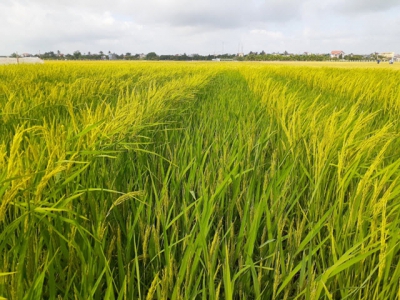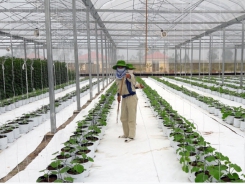Vietnamese hybrid rices path of development and good signals

A new generation of hybrid rice reaches 15 tons/ha in demonstration experiments, with yield potential up to 18 tons/ha, F1 hybrid seed production reaches a record of 6 tons/ha.
Producing F1 hybrid rice.
Why developing hybrid rice is a must
According to statistics from the General Department of Customs, in 2020, Vietnam exported 6.15 million tons of rice while imported 12.07 million tons of corn and 1.42 million tons of flour.
Considering the conversion, the amount of imported corn is equivalent to 9.3 million tons of rice, the amount of imported flour is 1.8 million tons of rice, excluding the import of over 1.2 million tons of soybeans, the import volume of corn and flour alone is 11.1 million tons of rice, which is a deficit of nearly 5 million tons.
These numbers speak, and Vietnam is not yet a country that ensures food security. The country still needs to increase rice yield. As Vietnam is heavily affected by climate change, hybrid rice is a very effective way to adapt to the situation in the future.
Barriers in the development of hybrid rice in Vietnam
Cognitive barriers:
More than 30 years have passed since the application of hybrid rice, but the comprehension of hybrid rice from management levels to grassroots officials is not always clear. Researchers’ knowledge about hybrid rice is not improved, not to mention lagging behind.
Most of the rice researchers do not understand how the third generation hybrid rice works (article by author Bui Ba Bong in the Vietnam Agriculture News No. 109 dated June 2nd, 2021 has clearly stated the three generations of hybrid rice), and what are the advantages only in hybrid rice that pure rice does not have.
Management and organization barriers:
Our hybrid rice research system is both lacking and weak: We have a hybrid rice research center, but it's not big enough. We don't acknowledge parental lines, only combinations, so instead of working to create excellent parental lines, research institutes chose to create new combinations. For research departments in our country, due to the parent line not being recognized, there is no sharing, the high potential good parent lines are kept as private property and not widely used.
Because of the lack of excellent parental lines to provide for the selection of new combinations, we have not been able to mobilize the participation of companies and provincial seed centers in the creation of new combinations, leading to very limited creation.
Genetic material barriers:
Due to various reasons, genetic material with high potential is very lacking. We have never had a specific topic to develop genetic material for hybrid rice. Useful genes such as Ydl1 (Yielding Locus1), Ydl2 (Yielding Locus 2), NPT (New plant type)..., which have made great strides in super hybrid rice, is almost never used in our country's research institutes. We also do not have the genetic material of the third generation hybrid rice.
Some achievements and directions in the future
Results on generating high potential genetic material:
The hybrid rice research team of the Vietnam National Academy of Agriculture persisted in the advanced direction and achieved some results to meet the development of hybrid rice in Vietnam.
Application of super green rice gene has increased the photosynthetic capacity of the leaves, increasing the efficiency of the source; The transfer of Xa21, Xa7 genes makes the hybrid rice highly resistant to blight, while the Pi1, Pita gene, and Pi54 gene for resistant parent lines are effective against rice blast. The group also succeeded in bringing together the target genes into a new generation of TGMS lines with high genetic potential, which served as the basis for creating super high yielding hybrid rice combinations.
Results of creating high yield hybrids:
The hybrid combinations between the new plant type female line and the high genetic potential male line have initially produced hybrids that yielded up to 15 tons/ha in Dak Lak in the demonstration experiment, typically the Viet Lai 50.
Recently a number of combinations belonging to the third class of the second generation hybrid rice have been created and are being tested for production. These hybrid rice combinations have the potential to yield up to 18 tons/ha, are resistant to blast and blight, and at the same time, trial production with F1 hybrid seeds has achieved a yield of 6 tons/ha.
Results of improved hybrid combinations that have been widely recognized:
Another very effective way is to add target genes to the parent line to create new generation hybrid rice combinations from varieties that have been widely cultivated in production, typically the new generation Viet Lai 20 and LC212 Blight Resistance (LC212KBL).
The hybrid rice research team of the Vietnam Academy of Agriculture has also created an aromatic hybrid rice variety with both high yield and good quality TH6-6 (Lai Thom 6). The yield of Th6-6 is equal to that of the highest yield hybrid rice but has a milder aroma, clear and sticky rice not inferior to the ST aromatic rice group.
The future path:
Strongly promote gene technology to create high potential TGMS and TPGMS lines belonging to the third class of the second generation hybrid rice.
Through gene technology, fully utilize the rice's strength genes to select and create restorer male lines R carrying target genes for yield and tolerance.
Strongly promote cooperation in sharing materials and developing combinations with potential businesses to quickly master the technology of producing high-yield hybrid seeds and put new hybrid combinations into production.
Establishing schools of hybrid rice research
Vietnam's hybrid rice development and management system need to be reorganized in which research institutes focus on the creation of high potential state-sponsored genetic material, while other companies and the provincial seed centers should be mobilized to participate in creating combinations, testing and putting into production, organizing the production of F1 hybrid seeds and commercializing the product.
The existing and future parent lines should be recognized as national property so that they are widely shared between companies.Their creators should be properly compensated and get supports to form schools with reputable leaders to help establish favorable international relations. It is also necessary to have a training class to improve knowledge for the hybrid rice creation team, focusing on experts who practice hybrid seed production and build hybrid rice villages to ensure the quantity and quality of F1 hybrid seeds at a lower cost.
Throughout his life of dedication to hybrid rice, Academician Yuan Longping has summed up his success in four words: knowledge, effort, inspiration and opportunity. With opportunities, he concluded: "Opportunities only come with preparation".
New opportunities for Vietnamese hybrid rice will come when there is preparation. Personally, I believe: "If we overcome the barriers and reorganize the system to be more efficient, the Vietnamese hybrid rice will develop strongly in the future".
Related news
Tools

Phối trộn thức ăn chăn nuôi

Pha dung dịch thủy canh

Định mức cho tôm ăn

Phối trộn phân bón NPK

Xác định tỷ lệ tôm sống

Chuyển đổi đơn vị phân bón

Xác định công suất sục khí

Chuyển đổi đơn vị tôm

Tính diện tích nhà kính

Tính thể tích ao




 Lai Thom 6 - Vietnam’s high quality hybrid…
Lai Thom 6 - Vietnam’s high quality hybrid…  Vietnamese coffee: Sustainable development to enhance the position
Vietnamese coffee: Sustainable development to enhance the position